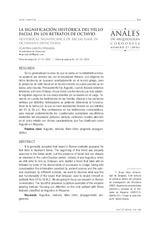Mostrar el registro sencillo del ítem
La significación histórica del vello facial en los retratos de Octavio
| dc.contributor.author | García Villalba, Claudia | |
| dc.date.accessioned | 2018-01-15T11:35:29Z | |
| dc.date.available | 2018-01-15T11:35:29Z | |
| dc.date.issued | 2016 | |
| dc.identifier.issn | 1130-9741 | |
| dc.identifier.uri | http://hdl.handle.net/10396/15835 | |
| dc.description.abstract | Se ha generalizado la idea de que la barba en la retratrística romana apareció por primera vez con el emperador Adriano. Los orígenes de dicha tendencia se buscaron acertadamente en el mundo griego, pero la presencia de vello facial en el mundo romano se puede percibir ya en época julio-claudia. Precisamente fue Augusto, cuando todavía debemos referirnos a él como Octavio, el que inició una tendencia que más adelante seguirían algunos de sus descendientes y/o sucesores en el cargo. Teniendo en cuenta los testimonios de las fuentes clásicas y las opiniones vertidas por distintos historiadores se pretende determinar la funcionalidad de la barba con la que se hace representar Octavio en sus retratos del 43 al 36 a.C. Nos centraremos en los testimonios numismáticos, para repasar posteriormente los cuestionados ejemplares escultóricos existentes del emperador portando barbula, centrando nuestra atención en el único retrato con dichas características que fue clasificado como Augusto en Hispania. | es_ES |
| dc.description.abstract | It is generally accepted that beard in Roman portraits appeared for first time in Hadrian’s times. The beginning of this trend was properly searched in the Greek world, but the presence of facial hair can already be observed in the Julio-Claudian period. Indeed, it was Augustus, when we still refer to him as Octavian, who started a trend that later will be followed by some of his descendants or successors in charge.Taking into consideration the information provided by ancient sources and the opinions expressed by different scholars, we want to discover what was the real functionality of the beard that Octavian used to depict himself in portraits from 43 to 36 B.C. We are going to focus our research in Roman numismatics. The doubtful preserved sculpture examples of the emperor wearing barbula, focusing our attention on the only portrait with these features classified as Augustus in Hispania. | es_ES |
| dc.format.mimetype | application/pdf | es_ES |
| dc.language.iso | spa | es_ES |
| dc.publisher | Universidad de Córdoba, Área de Arqueología | es_ES |
| dc.rights | https://creativecommons.org/licenses/by/3.0/ | es_ES |
| dc.source | Anales de Arqueología Cordobesa 27, 161-182 (2016) | es_ES |
| dc.subject | Augusto | es_ES |
| dc.subject | Barbula | es_ES |
| dc.subject | Mars Ultor | es_ES |
| dc.subject | Programa propagandístico | es_ES |
| dc.subject | Augustus | es_ES |
| dc.subject | Propagandistic programme | es_ES |
| dc.title | La significación histórica del vello facial en los retratos de Octavio | es_ES |
| dc.title.alternative | Historical significance of facial hair in Octavian's depictions | es_ES |
| dc.type | info:eu-repo/semantics/article | es_ES |
| dc.relation.publisherversion | https://www.uco.es/ucopress/ojs/index.php/anarcor/index | es_ES |
| dc.rights.accessRights | info:eu-repo/semantics/openAccess | es_ES |

